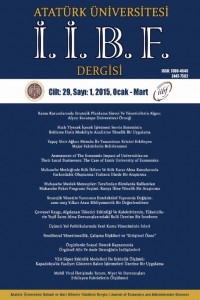Öz
Although substantial literature has accumulated regarding specific work life practices and their effects on individual outcomes, until recently little systematic attention has been paid to the overall climate of organizational work-life support and consequent employee attitudes and behaviors. In addition, most research has failed to go beyond the individual level of analysis. The present research is grounded in theories of social support and perceived organizational support. This study investigated relationships between perceptions of organizational and supervisory family support and organizational commitment, work-family conflict and family-work conflict. It was found that affective commitment was positively and work-family conflict was negatively influenced by perceptions of intangible (emotional) organizational family support. Also, it was found that affective commitment was positively affected by perceived organizational supervisory support
Anahtar Kelimeler
Social Support Organizational Family Support Perceived Supervisory Commitment
Kaynakça
- Allen, D.G., Shore, L.M., and Griffeth, R.W. (2003), “The role of perceived organizational support and supportive human resource practices in the turnover process”, Journal of Management, 29: 99-118.
- Allen, N.J. (2003), “Examining organizational commitment in China”, Journal of Vocational Behaviour, 62: 511-515
- Allen, T.D. (2001). “Family-supportive work environments: The role of organizational perceptions”, Journal of Vocational Behavior, 58: 414- 435
- Allen, T.D. ve Russell, J.E.A.. (1999), "Parental leave of absence: some not so family-friendly implications." Journal of Applied Social Psychology 29:166-191.
- Anderson, S. E., Coffey, B.S. ve Byerly, R.T. (2002), "Formal organizational initiatives and informal workplace practices: links to work-family conflict and job-related outcomes." Journal of Management, 28: 787- 810.
- Armeli, S., Eisenberger, R., Fasolo, P., ve Lynch, P. (1998), “Perceived organizational support and police performance: the moderating influence of socio-emotional needs”, Journal of Applied Psychology, 83: 288-297.
- Armstrong-Stassen, M. ve Ursel, N.D. (2009), “Perceived organizational support, career satisfaction, and the retention of older workers”, Journal of Occupational and Organizational Psychology, 82(1), 201- 220.
- Behson, S.J. (2002), "Which dominates? the relative importance of work-family organizational support and general organizational context on employee outcomes", Journal of Vocational Behavior, 61: 53-72.
- Bond, J.T., Thompson, C., Galinsky, E. and Prottas, D. (2003), Highlights of the 2002 national study of the changing workforce. New York, NY: Families and Work Institute.
- Casper, W.J., Martin, J.A, Buffardi, L.C. ve Erwins, C.J. (2002), "Work-family conflict, perceived organizational support, and organizational commitment among employed mothers", Journal of Occupational Health Psychology, 7:99-108.
- Chen, Z.X., Aryee, S. ve Lee, C. (2005), “Test of a mediation model of perceived organizational support”, Journal of Vocational Behavior, 66: 457-470.
- Chiang, C.F. ve Hsieh, T.S. (2012), “The impacts of perceived organizational support and psychological empowerment on job performance: The mediating effects of organizational citizenship behavior”, International Journal of Hospitality Management, 31: 180-190.
- Coyle-Shapiro, J.A.M. ve Conway, N. (2005), “Exchange relationships: examining psychological contracts and perceived organizational support”, Journal of Applied Psychology, 90: 774-781.
- Eisenberger, R., Huntington R., Hutchinson, S. ve Sowa, D. (1986), "Perceived organizational support", Journal of Applied Psychology, 71: 500-507.
- Erera, I.P. (1992) "Social support under conditions of organizational ambiguity", Human Relations, 45: 247-264.
- Fernandez, J.P. (1986), Child care and corporate productivity. Lexington, MA: Lexington Books.
- Frone, M. R., Russell, M. ve Cooper, M.L. (1992), “Antecedents and outcomes of work Family conflict: Testing a model of the work family interface,” Journal of Applied Psychology, 77, 1, 65-78.
- Frone, M.R., Yardley, J.K. ve Markel, K.S. (1997), "Developing and Testing an ıntegrative model of the work-family interface", Journal of Vocational Behavior, 50: 145-167.
- Galinsky, E., Friedman, D.E. ve Hernandez, C.A. (1991), The corporate reference guide to work-family programs. New York, NY: Families and Work Institute.
- Goff, S.J. ve Mount, M.K. (1990), "Employer supported child care, work/family conflict, and absenteeism: a field study", Personnel Psychology, 43: 793-809.
- Greenhaus, J.H. ve Beutell, N.J. (1985), "Sources of conflict between work and family roles", Academy of Management Review, 10: 76-88.
- Greenhaus, J.H. ve Parasuraman, S. (1986), "A Work-nonwork interactive perspective of stress and its consequences", Journal of Organizational Behavior, 8: 37-60.
- Greenhaus, J.H. ve Parasuraman, S. (1994), Work-family conflict, social support, and well-being. In M.J. Davidson ve R.J. Burke (Eds.), Women in management: Current research issues, London: Paul Chapman.
- Gutek, B.W., Searle, S. ve Klepa, L. (1991), "Rational versus gender role explanations for work-family conflict", Journal of Applied Psychology, 76: 560-568.
- Hochschild, A.R. (1997), The time bind: when work becomes home and home becomes work. New York, NY: Henry Holt & Company, Inc.
- House, J.S. (1981), Work stress and social support. Reading, MA: Addison- Wesley.
- Jahn, E., Thompson, C.A. ve Kopelman, R.E. (2003), "Rationale and construct validity evidence for a measure of perceived organizational family support (POFS): because purported practices may not reflect reality", Community, Work and Family, 6: 123-140.
- James, L.R., Demaree, R.G. ve Wolfe, G. (1993), “An assessment of within- group interrater agreement", Journal of Applied Psychology, 78: 306- 309.
- Karatepe, O.M. (2012), “Perceived organizational support, career satisfaction, and performance outcomes A study of hotel employees in Cameroon”, International Journal of Contemporary Hospitality Management, 24(5): 735-752.
- Kaufman, J.D., Stamper, C.L. ve Tesluk, P.E. (2001), "Do supportive organizations make for good corporate citizens?", Journal of Managerial Issues, 13 (4): 436-449.
- Kish, L. (1980), Survey Sampling. John Willey & Sons Inc.
- Kopelman, R.E., Rovenpor, J.L. ve Millsap, R.E. (1992), "Rationale and construct validity evidence for the job search behavior index: because intentions (and new year's resolutions) often come to naught", Journal of Vocational Behavior, 40: 269-287.
- Kottke, J.L. ve Sharafinski, C.E. (1988), "Measuring perceived supervisory and organizational Measurement, 48: 1075-1079. Educational and Psychological
- Lambert, S.J. (2000), "Added Benefit: the link between work-life benefits and organizational citizenship behavior", Academy of Management Journal, 43: 801-815.
- Likert, R. (1967), The human organization: Its management and value. New York, NY: McGraw-Hill.
- Mathieu, J. ve Zajac, D. (1990), "A Review and meta-analysis of the and antecedents, commitment", Psychological Bulletin, 108: 171-194. consequences of organizational
- Meyer, C.S., Mukerjee, S. ve Sestero, A. (2001), "Work-family benefits: which ones maximize profits?", Journal of Managerial Issues, 13(1): 28-44.
- Meyer, J. P. ve Allen, N.J. (1984),. "Testing the 'Side-bet' theory of organizational commitment: some methodological considerations", Journal of Applied Psychology, 75: 710-720.
- Meyer, J. P. ve Allen, N.J. (1991), "A three-component conceptualization of organizational commitment", Human Resource Management Review, 1: 61-89.
- Nelson, D.L. ve Quick, J.C. (1991), "Social support and newcomer adjustment in organizations: Attachment theory at work?", Journal of Organizational Behavior, 37: 543-554.
- Özdevecioğlu, M. (2003), “Algılanan örgütsel destek ile örgütsel bağlılık ilişkilerinin belirlenmesine yönelik bir araştırma”, Dokuz Eylül Üniversitesi İktisadi ve İdari Bilimler Fakültesi, 18, 2, 113-130.
- Perry-Smith, J.E. ve Blum, C. (2000), "Work-family resource bundles and perceived organizational performance", Academy of Management Journal, 43: 1107-1117.
- Piercy, N., Cravens, D., Lane, N., Vorhies, D., (2006), “Driving organizational citizenship behaviors and salesperson in-role behavior performance: the role of management control and perceived organizational support”, Journal of the Academy of Marketing Science, 34(2): 244-262.
- Podsakoff, P.M. ve Organ, D. (1986), “Self-reports in organizational research: problems and prospects”, Journal of Management, 12(4): 531-544.
- Rhoades, L. ve Eisenberger, R., (2002), “Perceived organizational support: a review of the literature”, Journal of Applied Psychology, 87(4): 698- 714.
- Stinglhamber, F., ve Vandenberghe, C. (2003), “Organizations and supervisors as sources of support and targets of commitment: a longitudinal study”, Journal of Organizational Behavior, 24: 251-270.
- Thomas, L.T. ve Ganster, D.C. (1995), "Impact of family-supportive work variables on work-family conflict and strain: a control perspective", Journal of Applied Psychology, 80: 6-15.
- Thompson, C.A., Beauvais, L.L. ve Lyness, L.S. (1999), "When work-family benefits are not enough: the influence of work-family culture on benefit utilization, organizational attachment, and work-family conflict", Journal of Vocational Behavior, 54: 392-415.
- Tsui, A.S., Pearce, J.L., Porter, L.W., ve Tripoli, A.M. (1997), “Alternative approaches to employee-organization relationships: does investment in employees pay off?”, Academy of Management Journal, 40: 1089- 1121.
- Tumwesigye, G. (2010), “The relationship between perceived organizational support and turnover intentions in a developing country: the mediating role of organizational commitment”, Journal of African Business Management, 4(6): 942-952.
- Wayne, S.J., Shore, L.M., ve Liden, R.C. (1997), “Perceived organizational support and leader-member exchange: a social exchange perspective”, Academy of Management Journal, 40: 82-111.
- Wethington, E. ve Kessler, R.C. (1986), Perceived support, received support, and adjustment to stressful life events. Journal of Health and Social Behavior, 27: 78-89.
- Yavaş, U., Karatepe, O.M. ve Babakuş, E. (2010), “Relative efficacy of organizational support and personality traits in predicting service recovery and job performances: a study of frontline employees in Turkey”, Tourism Review, 65(3): 70-83.
- Zhang, Y., Farh, J.L. ve Wang, H. (2012), “Organizational antecedents of employee perceived organizational support in China: a grounded investigation”, The International Journal of Human Resource Management, 23(2): 422-446.
Öz
Bugüne kadar birçok çalışmada organizasyonel veya amir desteğinin bireysel düzeyde çıktılara etkisine yönelik birçok araştırma yapılmıştır. Her ne kadar iş hayatındaki uygulamalar ve bu uygulamaların etkileri ile ilgili literatürde önemli çalışmalar yer alsa da, yakın geçmişe kadar organizasyonel iş hayatı desteğinin çalışan davranışlarıyla sistematik ilişkilerine yönelik çalışmalara az rastlanmaktadır. Mevcut bu araştırma, sosyal destek teorileri ve algılanan organizasyonel destek yaklaşımları üzerine kurulmuştur. Bu çalışmada, organizasyonlarından aile desteği hisseden çalışanların firmalarına bağlılığı, bu çalışanların işin aileyi engelleme (iş-aile) çatışması ile ailenin işi engelleme (aile-iş) çatışmasını algılama düzeyleri arasındaki ilişkiler araştırılmıştır. Çalışma sonucunda, algılanan organizasyonel soyut aile desteğinin duygusal bağlılık üzerinde pozitif, iş-aile çatışması üzerinde ise negatif bir etkiye sahip olduğu, ayrıca amir desteğinin ise duygusal bağlılık üzerinde pozitif yönlü bir etkide bulunduğu tespit edilmiştir.
Anahtar Kelimeler
Kaynakça
- Allen, D.G., Shore, L.M., and Griffeth, R.W. (2003), “The role of perceived organizational support and supportive human resource practices in the turnover process”, Journal of Management, 29: 99-118.
- Allen, N.J. (2003), “Examining organizational commitment in China”, Journal of Vocational Behaviour, 62: 511-515
- Allen, T.D. (2001). “Family-supportive work environments: The role of organizational perceptions”, Journal of Vocational Behavior, 58: 414- 435
- Allen, T.D. ve Russell, J.E.A.. (1999), "Parental leave of absence: some not so family-friendly implications." Journal of Applied Social Psychology 29:166-191.
- Anderson, S. E., Coffey, B.S. ve Byerly, R.T. (2002), "Formal organizational initiatives and informal workplace practices: links to work-family conflict and job-related outcomes." Journal of Management, 28: 787- 810.
- Armeli, S., Eisenberger, R., Fasolo, P., ve Lynch, P. (1998), “Perceived organizational support and police performance: the moderating influence of socio-emotional needs”, Journal of Applied Psychology, 83: 288-297.
- Armstrong-Stassen, M. ve Ursel, N.D. (2009), “Perceived organizational support, career satisfaction, and the retention of older workers”, Journal of Occupational and Organizational Psychology, 82(1), 201- 220.
- Behson, S.J. (2002), "Which dominates? the relative importance of work-family organizational support and general organizational context on employee outcomes", Journal of Vocational Behavior, 61: 53-72.
- Bond, J.T., Thompson, C., Galinsky, E. and Prottas, D. (2003), Highlights of the 2002 national study of the changing workforce. New York, NY: Families and Work Institute.
- Casper, W.J., Martin, J.A, Buffardi, L.C. ve Erwins, C.J. (2002), "Work-family conflict, perceived organizational support, and organizational commitment among employed mothers", Journal of Occupational Health Psychology, 7:99-108.
- Chen, Z.X., Aryee, S. ve Lee, C. (2005), “Test of a mediation model of perceived organizational support”, Journal of Vocational Behavior, 66: 457-470.
- Chiang, C.F. ve Hsieh, T.S. (2012), “The impacts of perceived organizational support and psychological empowerment on job performance: The mediating effects of organizational citizenship behavior”, International Journal of Hospitality Management, 31: 180-190.
- Coyle-Shapiro, J.A.M. ve Conway, N. (2005), “Exchange relationships: examining psychological contracts and perceived organizational support”, Journal of Applied Psychology, 90: 774-781.
- Eisenberger, R., Huntington R., Hutchinson, S. ve Sowa, D. (1986), "Perceived organizational support", Journal of Applied Psychology, 71: 500-507.
- Erera, I.P. (1992) "Social support under conditions of organizational ambiguity", Human Relations, 45: 247-264.
- Fernandez, J.P. (1986), Child care and corporate productivity. Lexington, MA: Lexington Books.
- Frone, M. R., Russell, M. ve Cooper, M.L. (1992), “Antecedents and outcomes of work Family conflict: Testing a model of the work family interface,” Journal of Applied Psychology, 77, 1, 65-78.
- Frone, M.R., Yardley, J.K. ve Markel, K.S. (1997), "Developing and Testing an ıntegrative model of the work-family interface", Journal of Vocational Behavior, 50: 145-167.
- Galinsky, E., Friedman, D.E. ve Hernandez, C.A. (1991), The corporate reference guide to work-family programs. New York, NY: Families and Work Institute.
- Goff, S.J. ve Mount, M.K. (1990), "Employer supported child care, work/family conflict, and absenteeism: a field study", Personnel Psychology, 43: 793-809.
- Greenhaus, J.H. ve Beutell, N.J. (1985), "Sources of conflict between work and family roles", Academy of Management Review, 10: 76-88.
- Greenhaus, J.H. ve Parasuraman, S. (1986), "A Work-nonwork interactive perspective of stress and its consequences", Journal of Organizational Behavior, 8: 37-60.
- Greenhaus, J.H. ve Parasuraman, S. (1994), Work-family conflict, social support, and well-being. In M.J. Davidson ve R.J. Burke (Eds.), Women in management: Current research issues, London: Paul Chapman.
- Gutek, B.W., Searle, S. ve Klepa, L. (1991), "Rational versus gender role explanations for work-family conflict", Journal of Applied Psychology, 76: 560-568.
- Hochschild, A.R. (1997), The time bind: when work becomes home and home becomes work. New York, NY: Henry Holt & Company, Inc.
- House, J.S. (1981), Work stress and social support. Reading, MA: Addison- Wesley.
- Jahn, E., Thompson, C.A. ve Kopelman, R.E. (2003), "Rationale and construct validity evidence for a measure of perceived organizational family support (POFS): because purported practices may not reflect reality", Community, Work and Family, 6: 123-140.
- James, L.R., Demaree, R.G. ve Wolfe, G. (1993), “An assessment of within- group interrater agreement", Journal of Applied Psychology, 78: 306- 309.
- Karatepe, O.M. (2012), “Perceived organizational support, career satisfaction, and performance outcomes A study of hotel employees in Cameroon”, International Journal of Contemporary Hospitality Management, 24(5): 735-752.
- Kaufman, J.D., Stamper, C.L. ve Tesluk, P.E. (2001), "Do supportive organizations make for good corporate citizens?", Journal of Managerial Issues, 13 (4): 436-449.
- Kish, L. (1980), Survey Sampling. John Willey & Sons Inc.
- Kopelman, R.E., Rovenpor, J.L. ve Millsap, R.E. (1992), "Rationale and construct validity evidence for the job search behavior index: because intentions (and new year's resolutions) often come to naught", Journal of Vocational Behavior, 40: 269-287.
- Kottke, J.L. ve Sharafinski, C.E. (1988), "Measuring perceived supervisory and organizational Measurement, 48: 1075-1079. Educational and Psychological
- Lambert, S.J. (2000), "Added Benefit: the link between work-life benefits and organizational citizenship behavior", Academy of Management Journal, 43: 801-815.
- Likert, R. (1967), The human organization: Its management and value. New York, NY: McGraw-Hill.
- Mathieu, J. ve Zajac, D. (1990), "A Review and meta-analysis of the and antecedents, commitment", Psychological Bulletin, 108: 171-194. consequences of organizational
- Meyer, C.S., Mukerjee, S. ve Sestero, A. (2001), "Work-family benefits: which ones maximize profits?", Journal of Managerial Issues, 13(1): 28-44.
- Meyer, J. P. ve Allen, N.J. (1984),. "Testing the 'Side-bet' theory of organizational commitment: some methodological considerations", Journal of Applied Psychology, 75: 710-720.
- Meyer, J. P. ve Allen, N.J. (1991), "A three-component conceptualization of organizational commitment", Human Resource Management Review, 1: 61-89.
- Nelson, D.L. ve Quick, J.C. (1991), "Social support and newcomer adjustment in organizations: Attachment theory at work?", Journal of Organizational Behavior, 37: 543-554.
- Özdevecioğlu, M. (2003), “Algılanan örgütsel destek ile örgütsel bağlılık ilişkilerinin belirlenmesine yönelik bir araştırma”, Dokuz Eylül Üniversitesi İktisadi ve İdari Bilimler Fakültesi, 18, 2, 113-130.
- Perry-Smith, J.E. ve Blum, C. (2000), "Work-family resource bundles and perceived organizational performance", Academy of Management Journal, 43: 1107-1117.
- Piercy, N., Cravens, D., Lane, N., Vorhies, D., (2006), “Driving organizational citizenship behaviors and salesperson in-role behavior performance: the role of management control and perceived organizational support”, Journal of the Academy of Marketing Science, 34(2): 244-262.
- Podsakoff, P.M. ve Organ, D. (1986), “Self-reports in organizational research: problems and prospects”, Journal of Management, 12(4): 531-544.
- Rhoades, L. ve Eisenberger, R., (2002), “Perceived organizational support: a review of the literature”, Journal of Applied Psychology, 87(4): 698- 714.
- Stinglhamber, F., ve Vandenberghe, C. (2003), “Organizations and supervisors as sources of support and targets of commitment: a longitudinal study”, Journal of Organizational Behavior, 24: 251-270.
- Thomas, L.T. ve Ganster, D.C. (1995), "Impact of family-supportive work variables on work-family conflict and strain: a control perspective", Journal of Applied Psychology, 80: 6-15.
- Thompson, C.A., Beauvais, L.L. ve Lyness, L.S. (1999), "When work-family benefits are not enough: the influence of work-family culture on benefit utilization, organizational attachment, and work-family conflict", Journal of Vocational Behavior, 54: 392-415.
- Tsui, A.S., Pearce, J.L., Porter, L.W., ve Tripoli, A.M. (1997), “Alternative approaches to employee-organization relationships: does investment in employees pay off?”, Academy of Management Journal, 40: 1089- 1121.
- Tumwesigye, G. (2010), “The relationship between perceived organizational support and turnover intentions in a developing country: the mediating role of organizational commitment”, Journal of African Business Management, 4(6): 942-952.
- Wayne, S.J., Shore, L.M., ve Liden, R.C. (1997), “Perceived organizational support and leader-member exchange: a social exchange perspective”, Academy of Management Journal, 40: 82-111.
- Wethington, E. ve Kessler, R.C. (1986), Perceived support, received support, and adjustment to stressful life events. Journal of Health and Social Behavior, 27: 78-89.
- Yavaş, U., Karatepe, O.M. ve Babakuş, E. (2010), “Relative efficacy of organizational support and personality traits in predicting service recovery and job performances: a study of frontline employees in Turkey”, Tourism Review, 65(3): 70-83.
- Zhang, Y., Farh, J.L. ve Wang, H. (2012), “Organizational antecedents of employee perceived organizational support in China: a grounded investigation”, The International Journal of Human Resource Management, 23(2): 422-446.
Ayrıntılar
| Birincil Dil | Türkçe |
|---|---|
| Bölüm | Makaleler |
| Yazarlar | |
| Yayımlanma Tarihi | 5 Şubat 2015 |
| Yayımlandığı Sayı | Yıl 2015 Cilt: 29 Sayı: 1 |





